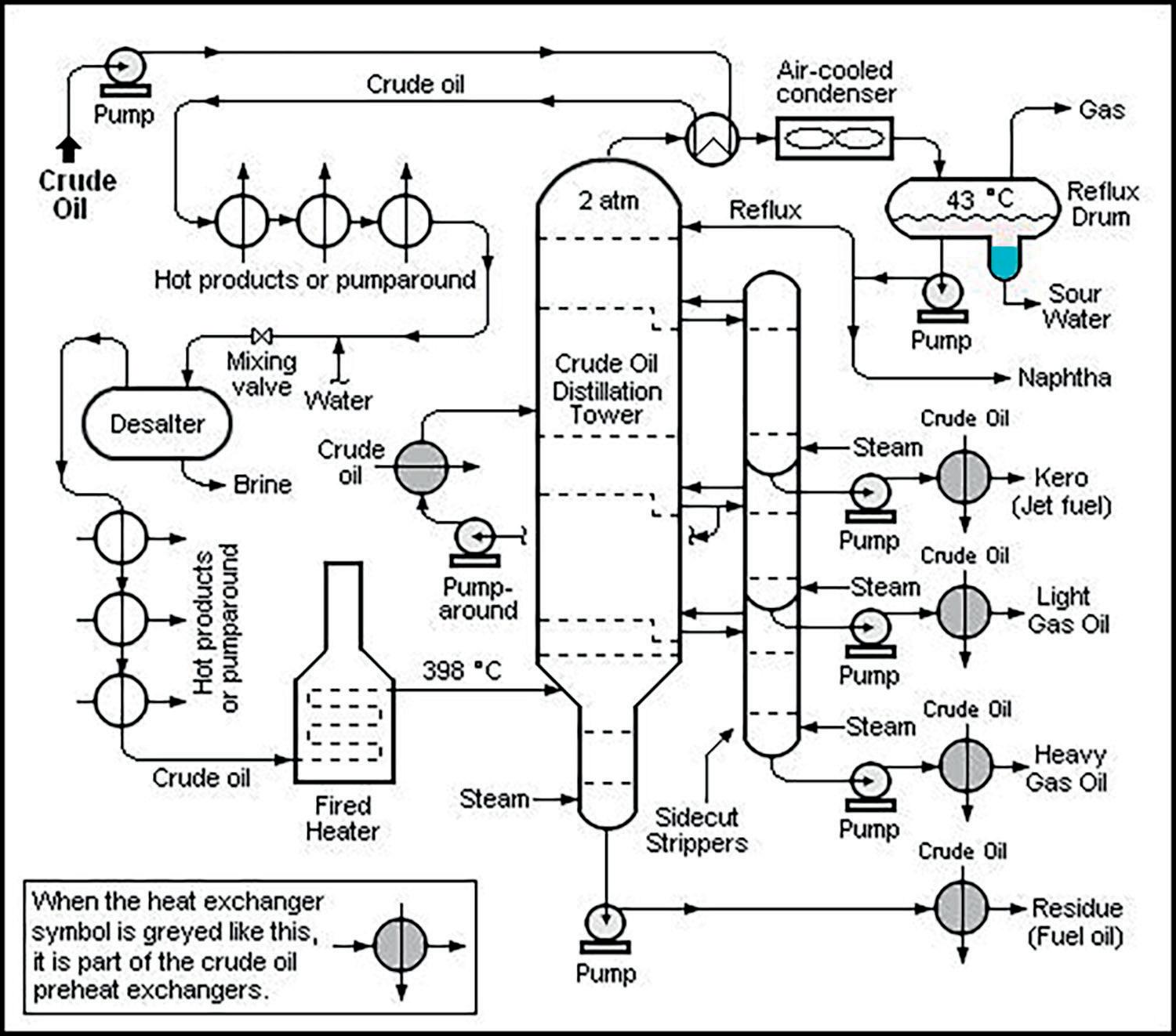
9 minute read
Not all water is equal
Lea Clauson, DeZURIK Inc., USA, discusses the importance of elastomer selection for petroleum refinery water.
Water plays an integral part in the petroleum refining process. A tremendous amount of water is used in a refinery – from mixing and separating the crude oil, to cooling the distillation tower with cooling water, and finally discharging the treated wastewater to surface water or wells. This is a general overview of the petroleum refining process, highlighting the composition of water at different stages in the refining process. However, this article will specifically discuss the importance of proper elastomer selection for seals in valves, pumps and gaskets in refinery processing equipment that handles these varying water compositions.
Water’s role in refining
In the petroleum refining process, crude oil is first prepared for refining in the desalter. The main purpose of the desalter
is to remove impurities such as sulfur, salts and contaminants from the crude oil by mixing it with water to separate it into a brine water stream and the desalted crude. Some crudes contain high concentrations of hydrogen sulfide (H2S), which is corrosive to metal processing equipment, so amines are added to the crude to tie up H2S and transport it with the brine water stream to wastewater treatment processing.1 Next, the desalted crude is heated to 398°C (748°F) before it enters the crude oil distillation unit (CDU), also known as the atmospheric distillation unit. Figure 1 is a typical flow diagram of the desalter and CDU used in petroleum oil refining.
The CDU is the front end of the petroleum refining process. Its purpose is to use heat to separate the desalted crude, which is a mixture of hydrocarbon compounds. The mixture is separated into fractions with similar boiling points, molecular weights and properties.3 These fractions include fuels such as gasoline, diesel fuel, jet fuel and others. The separated fuels then continue on for further processing.
Acids such as hydrochloric acid (HCl) build up in the CDU overhead systems and create highly-corrosive steam condensate that is damaging to process equipment. Amines are base chemicals that are injected into the overhead system to neutralise the acids and combat the corrosive environment.4 They are organic compounds derived from ammonia, where one or more hydrogen atoms are replaced by an alkyl group that is attached to one or more nitrogen atoms.5 The primary use of amines is in medications, nylon, and water purification.
Neutralising amines
Amines are injected into two different areas of the petroleum refining process. They are first injected into the desalter to tie up H2S and send it, with the brine water stream, to wastewater treatment processing. Secondly, amines are injected into the CDU overhead system to neutralise corrosive HCl. The overhead stream from the CDU mixes with cooling water from the cooling tower, and the cooling water cools and condenses the vapours in the CDU. As a result, amines are found in both wastewater and cooling water applications in a petroleum refinery.
Figure 1. Typical flow diagram of the CDU used in petroleum oil refining (source: Wikimedia Commons, 2020).2
Proper elastomer selection
Elastomers are used as seals in valves, pumps and gaskets in refinery processing equipment. The integrity of these seals is critical to controlling volatile organic compound (VOC) emissions from

Table 1. Chemical resistance guide for elastomers (source: Compass Publications, 1988)
Media Recommendations Nitrile (NBR) Ethylene (EP), propylene (EPDM) Pefluorinated elastomer Fluorinated copolymer
Amines EP C/NR at 70˚F AC to 70˚F A to 70˚F
Deionised water NBR, EP A to 70˚F; AB to 200˚F A to 70˚F; AB to 200˚F A = Excellent, little or no swelling, softening, or surface deterioration B = Good chemical resistance. Minor chemical attack, swelling, softening or surface deterioration C = Limited chemical resistance. Moderate chemical attack. Conditional service NR = Severe attack, swelling, softening, or dissolved within minutes to years. Not recommended A to 70˚F
wastewater systems. VOCs are usually industrial solvents that may have short- and long-term adverse health effects on operators.6 The allowable VOC discharge limit for a refinery is set by the Environmental Protection Agency (EPA). The EPA’s job is to enforce the environmental laws in order to protect human health and the environment.7 In a petroleum refinery, VOCs are typically industrial solvents such as benzene, hexane and toluene which may end up in the wastewater stream and could potentially contaminate the groundwater. If a refinery exceeds the allowable VOC limit, it will be required to clean up its processes and pay a fine.
As such, careful consideration is required in elastomer selection to prevent premature degradation as a result of incompatibility with the process media. Elastomer selection is typically ruled by two factors: chemical compatibility, and operating temperature. The incompatibility of an elastomer with a media can be physical or chemical. In a physical interaction, the elastomer will absorb the media liquid and swell, harden or crack. In a chemical interaction, the elastomer will undergo structural changes from degradation of the chemical components within the elastomer. The chemical degradation often reduces physical properties such as tensile strength and hardness. Higher operating temperatures often increase the degradation of the elastomer. The increase in temperature can create unwanted crosslinks in the elastomer, and may also decrease its flexibility.8
Case study
Case studies have found polytetrafluoroethylene (PTFE) to have superior chemical and temperature resistance to amines compared to elastomers.8 However, PTFE is generally not used as a sealing material in many applications because it lacks a critical physical property: resistance to compression set. Compression set is a material’s ability to return to its original thickness after prolonged compression stresses at a given temperature and deflection.9 Unlike elastomers, PTFE takes a compression set after one use. As such, PTFE is not a suitable seal material for many valve designs, pumps and gaskets without the means to provide memory (the ability of a material to bounce back to its original shape after compression). Memory is created in a PTFE seal by adding a spring, a snap ring, or another live-loading mechanism such as an elastomer.
Elastomer compatibility with water
If PTFE material is not a suitable sealing material, then elastomers are typically used as an alternative. There are many types of elastomers, and each has its own chemical and temperature resistance characteristics. The most common elastomers used for water service are acrylonitrile butadiene (NBR) and ethylene propylene diene monomer (EPDM). The general compatibility of NBR and EPDM with amine and demineralised water, also known as deionised water, is shown in Table 1. Although NBR is suitable for demineralised water, which is the start-up process media in cooling tower applications, it is not suitable with the amines that are present in the CDU overhead systems. The cooling tower water cools and condenses the vapours in the CDU overhead system that contains amines. The amines will cause the NBR to swell, soften or dissolve, which degrades the sealing ability of the part. Elastomeric swelling in a seal such as a valve seat can create an additional interference between moving parts, and may potentially tear the seat and create higher torque requirements to actuate the valve. Figure 2 is an amine chemical attack on a fluoroelastomer seal. The chemical attack caused the seal to swell, and increased the interference. Although perfluoroelastomers (FFKM) offer the best amine resistance, these are suitable for static seals but not recommended for dynamic sealing of a valve seat without additional support.11 In addition to this, FFKM can be an expensive elastomer depending on the size of the component. The most economical and chemically-compatible elastomeric material that is suitable for use with amines is EPDM. Besides defined process media and conditions, there are also undefined media and conditions. Undefined media may include media abnormalities such as amine injections; undefined conditions may comprise start-up, shutdown, emergencies or cleaning, which may include spikes in pressure and Figure 2. An example of a fluoroelastomer seal that has swollen as a temperature. Spikes in temperature can result of an amine chemical attack (source: Gallagher Seals).10 also affect elastomer selection. NBR is rated to 180°F whereas EPDM is rated to

250°F. These undefined conditions need to be considered and evaluated, as these undisclosed conditions are often more detrimental than the defined operating conditions, and can negatively impact the life of the elastomeric component.
Conclusion
The longevity of elastomeric seals used in valves, pumps and gaskets is critical to the continuous operation of a petroleum refinery and the avoidance of costly downtime, which results in loss of production. It is also critical to containing VOC emissions in wastewater discharge and to avoid costly environmental fines that are issued by the EPA.
Proper elastomeric material selection in a petroleum refinery requires experience and refining process knowledge to recognise that wastewater and cooling water includes not only water, but also additional chemicals such as amines. Amines are used to tie up H2S in the brine water stream that enters the wastewater treatment processing from the desalter, and to neutralise the acids that are produced in the overhead stream from the CDU.
While NBR is suitable for demineralised water, it is not suitable for amines. EPDM is chemically-compatible and offers higher temperature resistance to amines than NBR. It is also economically-favourable over fluorinated copolymers. As such, it is best practice to specify EPDM for most process water applications in a petroleum refinery.
References
1. BASU, S., ‘Impact of opportunity crudes on refinery desalter and wastewater treatment performance-Part 1’,
Hydrocarbon Processing, Water Management, Headworks Int’l, (2018). 2. BEYCHOK, M., ‘Crude Oil Distillation Unit.png’, Wikimedia Commons, (2020), www.commons.wikimedia.org/ wiki/File:Crude_Oil_Distillation_Unit.png 3. NICHOLS, L., ‘Uses of Fractional Distillation’, Chemistry LibreTexts, (2022). 4. VETTERS, E., ‘Neutralising amine selection for crude units’, ProCorr Consulting Services, (2021). 5. ‘Physical Properties of Amines with Characteristics’, BYJU’S, (2022), www.byjus.com/chemistry/physical-properties-ofamines/ 6. ‘What are volatile organic compounds (VOCs)?’, US Environmental Protection Agency (EPA), (2022), www.epa.gov/ indoor-air-quality-iaq/what-are-volatile-oranic-compounds-vocs 7. ‘Basic Information on Enforcement’, US EPA, (2022), www.epa.gov/enforment/basic-information-enforcement 8. WAYUTA, S., ‘Physical and Chemical Resistance of Elastomers in Carbon Dioxide-Loaded Aqueous Monoethanolamine Solutions During Amine-Based Carbon Dioxide Capture’, The University of Regina (Canada) ProQuest Dissertations Publishing, (2013), www.proquest.com/docreview 9. ‘Compression Set of Elastomeric Materials’, Stockwell Elastomerics, Inc., (2022), www.stockwell.com/ compression-set-testing/ 10. Permission granted by Gallagher Fluid Seals, Inc., https://www.gallagherseals.com/ 11. ‘When to Use Perfluoroelastomers’, Eclipse Engineering Inc., (2022), http://eclipseseal.com/blog/seals/seals-seasonsperfluoroelastomers/
Page Number | Advertiser 19 | Alleima 39 | AMETEK Process Instruments IBC | Berndorf Band Engineering GmbH 28 | Blasch Precision Ceramics 53 | Borsig GmbH 31 | Comprimo IFC | Curtiss-Wright EST Group 67 | ERTC 02 | Eurotecnica
OFC & 49 | Honeywell Connected Industrial 11 | IPCO

AD INDEX
43 | Kurita 54 | NAPCON 65 | NISTM 15 | Optimized Gas Treating, Inc. 33, 46, 61 & 62 | Palladian Publications OBC | Paqell 16 | REMBE® GmbH Safety + Control 27 | Rotoflow, an Air Products business 13 | SBW Group 37 | Selective Adsorption Associates, Inc. 04 | Shell Catalysts & Technologies 07 | Sulzer Chemtech










